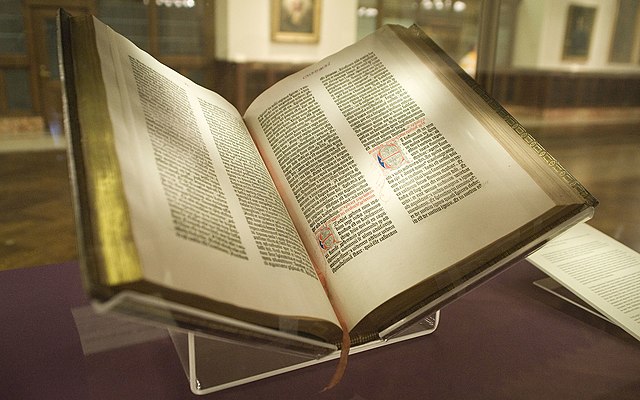
Why is the Gutenberg Bible special? Because it was the first mass-produced book made with movable type.
The Gutenberg Bible is named for Johannes Gutenberg, who famously perfected movable type printing using interchangeable metal letters. Movable type means that all of the characters can be moved. Gutenberg used a set of about 290 characters. These were the letters, lower and uppercase, plus all of the punctuation. The characters were carved into the end of long metal keys and they would be arranged in a container that was then fixed to the press. Each book was different, but with the Gutenberg Bible he probably printed six pages at the same time and would have set over 15,000 characters. The characters were then inked and Gutenberg had to invent a new ink for this process. Inks used for writing were usually water-based, which would not work on a printing press because they would drop off the characters. Gutenberg mixed ink with different metals and made a type of varnish that wouldn’t drip off the press and stuck to the pages. The press was closed, the text was printed, the pages were taken out to dry, and the process was repeated. This was movable print.
Gutenberg started printing in approximately 1450 and he produced 180 copies of his bible in 1455. Forty-nine of those copies still survive and it is one of the world’s most valuable books. However, the Gutenberg Bible wasn’t the first mass-produced book and Gutenberg wasn’t the first person to use movable type. A system of movable type using ceramic characters had been invented in China in about AD 1000. Bronze movable type characters have been found from the 12th century in China as well. Some Chinese printers also used wooden movable type. However, the problem with these methods was their durability. Bronze and wood are both fairly soft. With repeated use, the characters can become difficult to read. Gutenberg came up with a way of casting the characters out of an alloy of lead, tin, and antimony, which were much stronger.
Gutenberg printed 180 of his bibles. 50 of them are printed on vellum, which is paper made from the skin of a calf, and the other 130 are printed on paper. They have 40 lines per page for the first 9 pages and 42 lines for the rest. Gutenberg changed the way he was printing them to save money. The pages are 40 cm high by 28.6 cm wide, which means they were printed on a size of paper known as “Royal” and then trimmed down. The books have 1.286 pages, bound in two volumes. Both of the volumes together weigh about 30 kg. All of the existing books are very slightly different in some way because even though the movable type method meant books could be mass-produced, the machines were still run by people and they couldn’t repeat everything in exactly the same way each time.
So, why is the Gutenberg Bible special? The book in itself was not as special as what it meant to be able to produce it. Before the printing press, books were copied by hand, which took a very long time and was very expensive. Only people who could afford books could read and only people who could afford to have their books copied could pass on what they wanted to say. The printing press changed that. Anybody with a press and a set of movable type characters could reproduce books and they could make many of them. The price of books dropped rapidly. And the new ability to print caused people to rethink the way they made paper and the price of that fell as well.
Within several years of the Gutenberg bible, a distribution network for books began to appear and printing presses in other locations sprang up. Knowledge could suddenly be shared and more people had access to books so the literacy rate rose. People began to question religion and the church, and scientific thinking began to increase. People could talk about politics and newspapers could be written. The discoveries behind the Gutenberg Bible were the initial cause for the scientific revolution, the agricultural revolution, the industrial revolution, and many political revolutions.
So, why is the Gutenberg Bible special? It is special because it is a beautiful book and one of the first mass-produced books in Europe, but more than that, it is special because it was the moment where all of society began to change. And this is what I learned today.
Sources
https://www.history.com/news/printing-press-renaissance
https://en.wikipedia.org/wiki/Wang_Zhen_(inventor)
https://www.history.com/topics/inventions/printing-press
https://www.historytoday.com/reviews/gutenberg%E2%80%99s-bible-real-information-revolution
https://en.wikipedia.org/wiki/Movable_type
https://en.wikipedia.org/wiki/Johannes_Gutenberg
https://en.wikipedia.org/wiki/Gutenberg_Bible
https://www.history.com/news/7-things-you-may-not-know-about-the-gutenberg-bible
